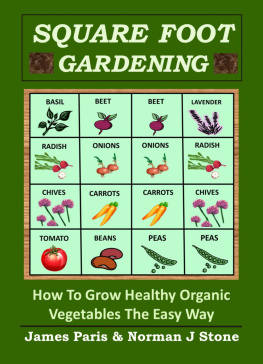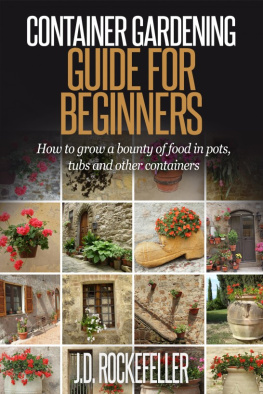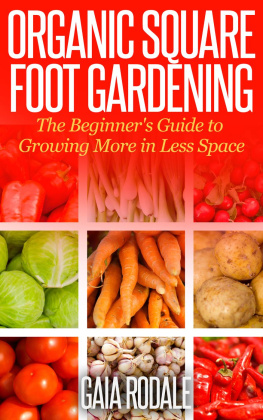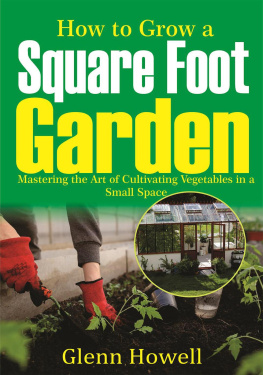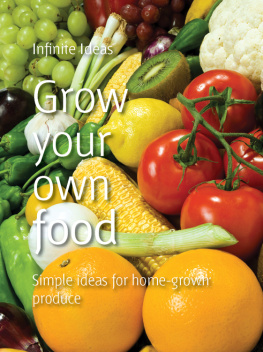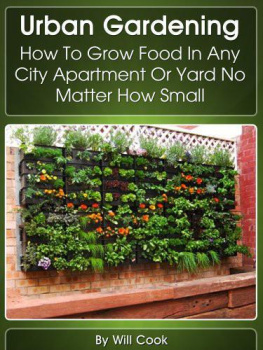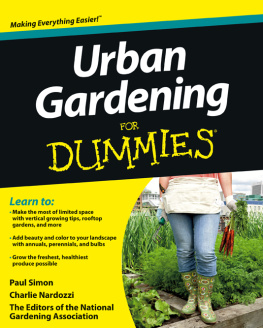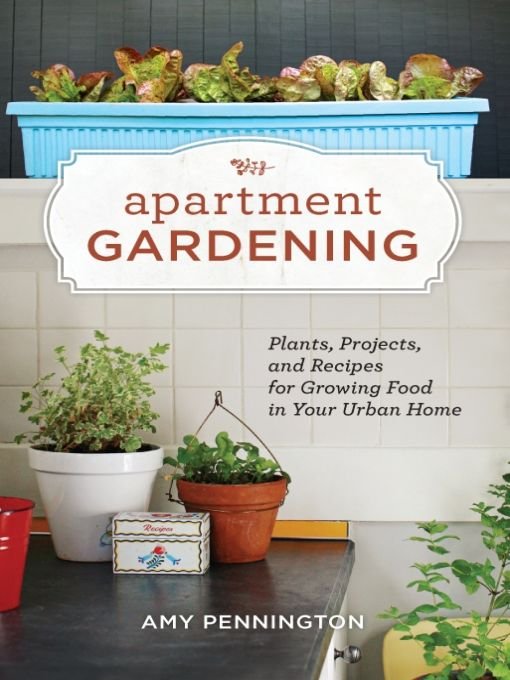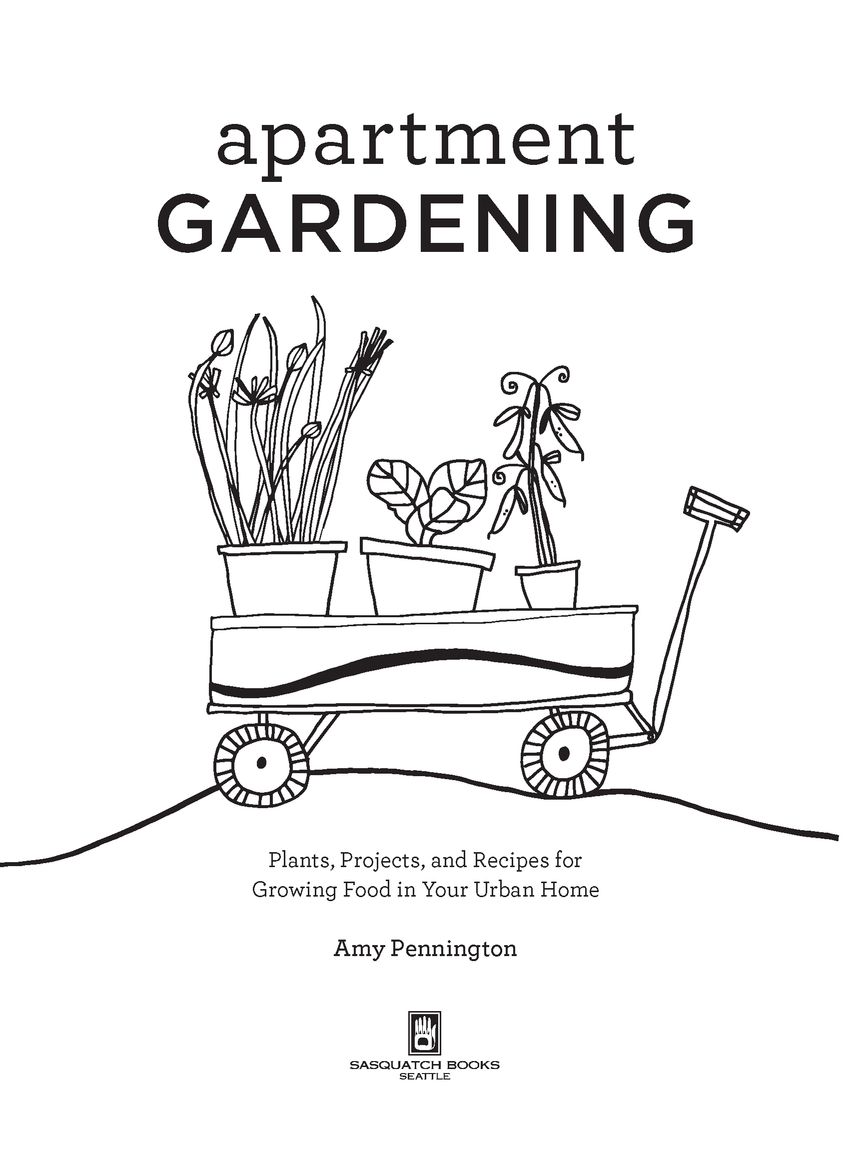Table of Contents
Acknowledgments
I would like to thank my daddio, Seth Dorian Pennington, Jr., for having an insatiable verve for living off the land, so much so that in retirement he moved himself, his lady, and a herd of goats out to the countryside of Pennsylvania and nestled them all against the banks of a mountain-fed stream.
Thank you to the team at Sasquatch Books who kept our garden conversation alive and well over many growing seasonsGary Luke and Susan Roxborough. To Michelle Hope Anderson for her patience and help, and especially to Whitney Ricketts for yelling at me over a martini to Write the damn book, already!
Super big fat thank-you to the awesome design team that put their hot little hands on this bookdesigner Jessika Merrill and illustrator Kate Bingaman-Burt.
I owe a huge, huge thank-you to Patric Gabre-Kidan, one of my very best friends and an overall Mr. Fix-It who has been the most incredible teacher over the years. He has single-handedly taught me how to change a tire, hold a chefs knife properly, and build my own vegetable planter box. He is my superhero.
Thank you to John Chaffetz, who started out as a garden client, and grew into an extraordinary friend and collaborator. Brainstorms, laughter, and good food are never in short supply when he is around.
Big thanks and some serious neighborly love to my fellow apartment dwellers: Katie Okumura, who always offers to water my plants when Im gone, and Frank Martin, who always lets me squeeze a few extra things into his fridge when mine is (more often than not) overflowing with food. And thanks to Jacci and Ann-Marie with whom I trade flowers and food with often. Viva La Tara!
Farm thanks to Luke Woodward and Sarah Cassidy, who run Oxbow Farm. They taught me, early on, how to sow seed and time my plantings. They are brilliant, and I love them.
I have so much gratitude for Lucio and Marta Dalla Gasparina, who had the excellent idea that I should grow their Nonnas Italian tomatoes in their yard for them. They didnt know they were creating a monster and lighting a spark in my life, and for that I am eternally grateful.
Double special thanks to Lynda Oosterhuis for always sharing her cooking secrets. She is one of the most amazing cooks I know.
As always, thank you to my family: Mom, Stacy, Seth, Gram, and the gaggle of nieces and nephews who crack me up daily. Love and thanks to my BK family: David, Carol, Dan, and Lil.
And finally, thank you to anyone reading these thank-yous! Your interest in and support of all things urban farm and garden are utterly inspiring. Keep growing!
Introduction
I am an urban gardener. Some may think of me as an urban farmer, depending on how you differentiate between a farm and a garden. I grow food for people in their city backyards, front yards, side yards, you name it: any patch of land in which I can persuade food to grow. And by food, I mean greens, roots, fruits, herbs, flowers, and more. My hope is to inspire people to eat a broader range of food and flavors than they are used to. I also want to evoke a sort of small-scale self-sufficiency in the daily lives of urbanites. People are sometimes inspired by what I do, but Im not especially gifted in any way. Ive killed damn near every houseplant Ive ever owned, so I wouldnt say I was born with a green thumb. And I dont have a lengthy rsum in agriculture or horticulture. I am no expert at identifying plants, and I certainly dont ever remember the Latin names. Really, I just like food. A lot. So I want to have a steady supply of fresh and delicious produce as often as possible. I am motivated by my hunger, and so I grow food.
The ironic thing about my story is that, at present, I do not actually have a garden of my own. I live in a small apartment in Seattle with no access to a backyard, a lawn, or even green space. And though I often dream of tearing up my assigned parking spot and building a raised vegetable bed in its place, I dont think my landlord would appreciate the effort. So like most city people in search of greener pastures, I make do with what I have: in my case, an east-facing deck that gets the first rays of morning sun. Over time, I have overcrowded this tiny 75-square-foot space with pots, containers, hanging baskets, window boxes, and more. (I also use my dining room table as a greenhouse in the winter, which means inviting plants to further encroach on what little personal space I have.) I originally started with flowers and killed a good number of them. I now know that I wasnt watering efficiently, or the pots were too small, but at the time I just chalked it up to a big experiment.
My relationship with plants changed when I was asked to build and plant an organic vegetable garden for a food-loving Seattle couple. They hoped to grow the same tomatoes their Nonna grew in Italy. While I had little firsthand knowledge on how best to do this, I thought it sounded like an awesome challenge, so I dug in. Putting my hands in the dirt for the first time and sowing seeds was immediately very natural for me. I remember looking up at my friend Marcus (who worked with me that first year) and saying, Marcus, this is the most instinctual thing Ive ever done. I didnt have to think about it. I just planted. And like most new gardeners, I was shocked and amazed when those little green seedlings started pushing out of the soil. Nearly everything came up that year, and the garden was a huge success.
From then on, I was officially a grow-your-own convert, and I started experimenting with all sorts of plants. I grew spices, ate flowers, sowed Asian greens (some names of which I still cant pronounce), tried ten varieties of paste tomatoes, and more. The more time I spent in the garden, the more obvious the life cycle of plants became. I learned what it meant to overwater or underwater. I did plant trials in each of the raised beds to see how sun patterns would affect growth. All in all, I became really good at growing food efficiently and maximizing space. It was like a little game I played with myselfhow much food can I grow in this small space in the shortest amount of time?
After that first year (and after getting used to bringing home some of the gardens bounty), I quickly tired of running across town to clip a handful of thyme for dinner. I refused to buy herbs at the grocery when I had fresh herbs to pick, but the back-and-forth car trips demanded too much energyI disliked having to plan meals too far ahead, and being environmentally minded I felt guilty for burning the fuel. In the length of a summer, I slowly transitioned all of the flower pots at my apartment to containers of edible plants. Today, my deck overflows with pots, soil, and plants. I still have a thyme plant from that first garden thriving in a big terra-cotta pot on my balcony. I didnt really think about the transition happening just outside my doorit just happened organically.
In truth, I have grown food and plants far longer than my short adult history would suggest. I grew up in the wilds of Long Island in New York. My parents had defected from Brooklyn and Queens to live a simple life out in the country. And although my childhood home sat within spitting distance of the Long Island Expressway, it really did feel like country. Our house was tucked in at the edge of a dead-end street. The yard was backed by a few acres of wooded land with meandering trails. The front yard started off like any old front yard, full of willow trees and a green lawn to run and do somersaults across, but over time my dad transitioned it to a working homestead. He built a gated pen for milk goats and another one for our pig, Maggie. We had rabbits for meat up in hutches, and one year we raised commercial turkeys for Thanksgiving, selling them to all his city friends. Muscovy ducks just sort of wandered around the yard, laying eggs where they saw fit. We would clip their wings every couple of months because if we didnt, they had a tendency to fly up and perch on the neighbors roof. There was a large coop for the chickens, though they had free rein and could easily be corralled back to the coop at night.







